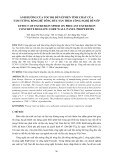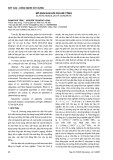
TNU Journal of Science and Technology
229(06): 211 - 219
http://jst.tnu.edu.vn 211 Email: jst@tnu.edu.vn
STATIC ANALYSIS OF CORRUGATED PLATE MADE COMPOSITE
MATERIAL BASED ON THE EQUIVALENT ORTHOGONAL PLATE MODEL
Nguyen Dinh Ngoc*, Nguyen Thi Thu Linh
TNU - University of Technology
ARTICLE INFO
ABSTRACT
Received:
14/3/2024
Folding plates with wavy shapes made of composite materials have been
widely applied, hence designing this type of structure is significant in
practice. In this research work, the results of static calculation of the
sinusoidal corrugated composite plates will be analyzed. Instead of
calculating the displacements on the actual corrugated plate, it can be
analytically obtained from the equivalent orthogonal plate. Both bending
and membrane stiffness constants are equivalently converted according
to the suggestion of the early researcher in the literature. The
displacements given by the analytical method on the equivalent plate are
compared with those resulting from the finite element method on the real
sinusoidal corrugated plate. The results show that the difference in the
values of displacements along the x and y directions of the center
between the two methods is small. The maximum relative error is 7.33%.
From this, it can be seen that the proposed model can be extended to
static as well as dynamic calculations for corrugated plates with
trapezoidal, triangular shapes, or can be applied to calculate the natural
frequency of the corrugated plate on an equivalent orthogonal flat plate.
Revised:
31/5/2024
Published:
31/5/2024
KEYWORDS
Corrugated plate
Finite element method
Equivalent orthogonal plat
Membrane and flexural stiffness
Composite material
PHÂN TÍCH TĨNH TẤM COMPOSITE LƯỢN SÓNG
DỰA TRÊN MÔ HÌNH TẤM TRỰC HƯỚNG TƯƠNG ĐƯƠNG
Nguyễn Đình Ngọc*, Nguyễn Thị Thu Linh
Trường Đại học Kỹ thuật Công nghiệp - ĐH Thái Nguyên
THÔNG TIN BÀI BÁO
TÓM TẮT
Ngày nhận bài:
14/3/2024
Các tấm gấp dạng lượn sóng làm bằng vật liệu composite đã được ứng
dụng rộng rãi nên việc thiết kế dạng kết cấu này có ý nghĩa trong thực tế.
Trong bài báo này, các giá trị chuyển vị của các điểm dọc theo đường ở
giữa mỗi cạnh của tấm composite sóng hình sin sẽ được tính toán dựa
trên hai mô hình. Mô hình phần tử hữu hạn tính toán trên kết cấu lượn
sóng 3D, trong khi đó phương pháp giải tích được sử dụng trên mô hình
tấm phẳng trực hướng tương đương. Các hằng số của độ cứng màng và
độ cứng uốn sẽ được quy đổi đồng thời trong nghiên cứu này. Chuyển vị
được xác định từ hai phương pháp kể trên sẽ được so sánh với nhau. Kết
quả cho thấy tỉ lệ phần trăm sai khác nhau lớn nhất của chuyển vị tính
được từ hai phương pháp là 7,33%. Kết quả sai khác này có thể chấp
nhận được trong phạm vi cho phép, và khẳng định đô tin cậy của mô hình
đề xuất nhằm giảm thời gian tính toán tĩnh của kết cấu lượn sóng 3D
thông qua một mô hình tấm phẳng tương đương, giảm thời gian tính
toán, tăng hiệu quả sản xuất. Ngoài ra, có thể thấy rằng mô hình đề xuất
có thể mở rộng để tính toán động cho các tấm sóng có dạng hình thang,
tam giác hoặc có thể áp dụng để tính tần số tự nhiên của tấm sóng trên
một tấm phẳng trực giao tương đương.
Ngày hoàn thiện:
31/5/2024
Ngày đăng:
31/5/2024
TỪ KHÓA
Tấm lượn sóng
Phương pháp Phần tử hữu hạn
Tấm tương đương
Độ cứng màng và uốn
Vật liệu composite
DOI: https://doi.org/10.34238/tnu-jst.9888
* Corresponding author. Email: ngocnd@tnut.edu.vn






























